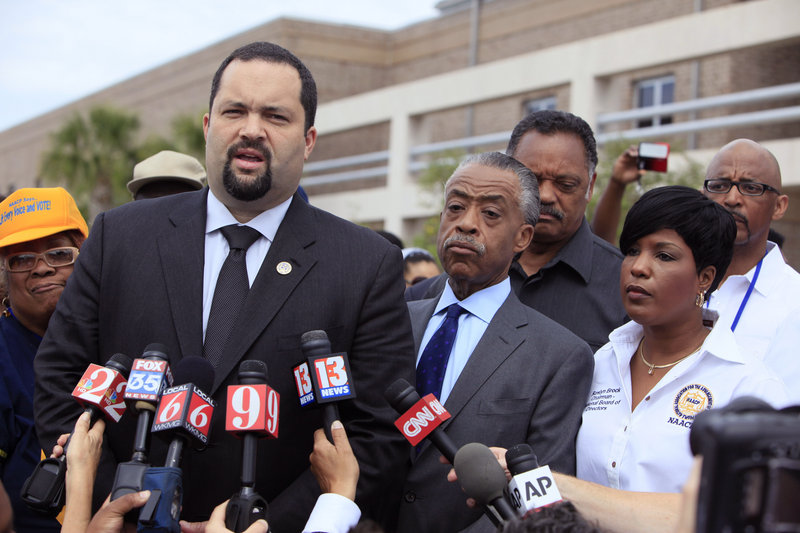MIAMI — The news media are taking on an increasingly police-like role in the Trayvon Martin slaying by using modern forensic techniques to analyze evidence, an approach some legal experts say can lead to a distorted view of the case because a lot of the key evidence is still under wraps.
The public has been whipsawed back and forth as new revelations emerge, appearing to support one version or the other.
Most recently, the Orlando Sentinel had a voice analysis expert examine a 911 call in which a person is heard screaming for help before the fatal gunshot. The gunman, neighborhood watch volunteer George Zimmerman, told police he was yelling, but the expert told the newspaper the voice most likely was not Zimmerman.
“It would be nice to know who was doing the calling for help, but identifying the caller is not necessarily going to definitively identify the wrongdoer,” said University of Florida law professor Bob Dekle, a former state prosecutor and public defender. “Situations sometimes arise where it is the wrongdoer calling for help.”
ABC AIRS POLICE VIDEO
ABC News on Monday aired what it said was an enhanced version of a police video taken the night of the shooting that appeared to show wounds or welts on the back of Zimmerman’s head.
The initial, grainier video aired last week seemed to show no wounds or blood, which led Martin’s family and supporters to proclaim that it undercut Zimmerman’s story.
Legal and forensic experts cautioned that none of the media-led investigations, which are done in many high-profile cases, has been conclusive.
“The public needs to know that this is a very complex case,” said Ron Martinelli, a forensics consultant in Temecula, Calif. “There are many issues that come into play and sometimes come into conflict.”
911 TAPE AT ISSUE
Zimmerman told police that he was attacked by Martin on Feb. 26 and believed he had no choice but to fire his gun at Martin in self-defense. The teenager’s family believes Zimmerman, 28, singled out Martin as suspicious because he was black. Zimmerman’s father is white and his mother is Hispanic.
The family also said Zimmerman should have listened to a police dispatcher who told him not to follow Martin.
The 911 call analysis compared the screams of “Help” to other recordings of Zimmerman’s voice using a computerized matching technique.
The consultant, Tom Owen, told the Sentinel that the comparison showed a 48 percent match between the two samples. A positive match should be above 90 percent, he said. Owen did not respond to an email Monday seeking additional comment.
If Zimmerman is charged and the case goes to court, the defense would likely hire experts to punch holes in any conclusions about the 911 tape or the police video.
“The other side will have experts saying ‘you can’t make anything out of this, it’s all garbled, look how much they had to enhance it,’ ” said Robert Jarvis, a law professor at Nova Southeastern University. “What has been done with the tape? Has anybody tampered with it?”
News organizations also used audio technology to enhance a 911 call in which some reported that Zimmerman muttered a racial epithet under his breath. Other media organizations, including The Associated Press, said the raw recording was not clear enough to determine what Zimmerman actually said.
SPEAKING FROM THE DEAD
Experts have also said that photos initially released of Martin and Zimmerman could have skewed initial public perceptions.
Most of the photos of Martin show a baby-faced boy in a red T-shirt or football uniform, much younger than the tall teenager he was the night of the shooting. And Zimmerman no longer resembles the beefy-looking figure pictured in a mug shot from several years ago.
Special prosecutor Angela Corey has been appointed by Gov. Rick Scott to lead the investigation after Sanford officials declined to make an arrest. The Justice Department and FBI are also investigating.
Many of the unanswered questions, especially the forensic results, will provide a more complete picture of how Zimmerman came to shoot Martin that night, Martinelli said.
“The decedent gets to have a voice only through forensics,” he said. “That’s how people speak from the dead.”
Send questions/comments to the editors.





Success. Please wait for the page to reload. If the page does not reload within 5 seconds, please refresh the page.
Enter your email and password to access comments.
Hi, to comment on stories you must . This profile is in addition to your subscription and website login.
Already have a commenting profile? .
Invalid username/password.
Please check your email to confirm and complete your registration.
Only subscribers are eligible to post comments. Please subscribe or login first for digital access. Here’s why.
Use the form below to reset your password. When you've submitted your account email, we will send an email with a reset code.